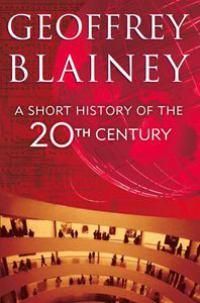
- Free Article: No
- Contents Category: History
- Review Article: Yes
- Article Title: Blainey’s way
- Online Only: No
- Custom Highlight Text:
Geoffrey Blainey made his reputation as a prolific and accomplished economic historian, then turned to broader themes and wrote important analytical works, including The Tyranny of Distance (1966), The Causes of War (1973), The Triumph of the Nomads (1975), and The Great Seesaw (1988). When the so-called ‘history wars’ began in the 1980s, Blainey was characterised as an optimistic conservative, critical of ‘the black armband’ view of Australian history attributed to the more radical Manning Clark. I thought the differences between Clark and Blainey were grossly exaggerated. Paradoxically, Blainey took a serious interest in Aborigines and women’s issues long before Clark did.
- Book 1 Title: A Short History of the 20th Century
- Book 1 Biblio: Viking, $49.95 hb, 561 pp
- Book 1 Cover Small (400 x 600):

- Book 1 Cover (800 x 1200):

I should declare an interest. In 1999 I was flattered when Geoffrey Blainey invited me to read the proofs of his A Short History of the World and to make suggestions. Like that book, A Short History of the 20th Century exhibits the sweep of Blainey’s learning, lucid expression and narrative gift.
The book, elegantly presented, has twenty-seven chapters, with fifteen maps but no photographs, other than an image of New York’s Guggenheim Museum on the dust jacket (an odd choice, since architecture, painting and sculpture are nowhere referred to). Blainey describes it as a narrative history, dominated by ‘two massive wars and a nervous peace’. But he writes from the perspective of economic man, rather than political man (and/or woman).
Blainey is compelling on processes and discoveries, and how science and technology change lives. Examples are the dramatic population increases caused by health improvements and dramatic falls in infant mortality; growth in agricultural productivity; the increasing urban phenomenon and the growth of ‘monster cities’, especially in the Third World; the impact of motor vehicles, aviation, and container ships; access to and the influence of mass media; the significance of sport in creating national heroes and the development of globalisation.
Blainey’s summary of Einstein’s brilliance, rocketry and the space race is exemplary. But there are slips. It is misleading to write about Edison’s phonograph and Baird’s mechanical system of television as forerunners of modern techniques: both were technological dead-ends. His account of the elucidation of DNA’s double-helical structure by Francis Crick and Jim Watson suggests that Rosalind Franklin ‘generously passed on ideas’: her assistance was unwilling and unwitting, and she was a profound sceptic about the double helix hypothesis.
Chapter 15, ‘A Curtain Falls’, describes how the Cold War began, then gives a succinct summary of Mao Zedong’s rise to power in China and the ‘cultural revolution’ of the 1960s. Chapter 16, ‘Burning Spear and Changing Wind’ deals with decolonisation, with particular emphasis on India, Indonesia, Kenya, and South Africa up to 1964. Blainey paints a sympathetic portrait of Mahatma Gandhi. Chapter 20, ‘Climbing the Everests’, about expanding human capacity, includes a condensed history of computing, paying tribute to Charles Babbage’s manually operated ‘difference engine’ in the nineteenth century, and to Alan Turing for his formal theory of how a universal computer would work, and for breaking the German Enigma naval codes. He refers to Turing’s suicide (cyanide poisoning) at the age of forty-one, but cautiously refrains from revealing the reason (depression after conviction for a homosexual offence).
Chapter 22, ‘A Seesaw Moves’, summarising Blainey’s earlier book of a similar name on cultural, social and political change, is strongly argued. His material on the ‘Green Crusade’ is conservative, and agnostic about global warming (‘We still stand in the dark’), even after the US at the recent Gleneagles Summit reluctantly signed up to the communiqué, which acknowledged human impact on climate change. He describes the revolution created by the contraceptive pill, and the rise of feminism and the accession of powerful women, notably Indira Gandhi and Margaret Thatcher, to high office (not quite the same thing). His account of the moves towards desegregation in the US praises Martin Luther King, who gained international recognition from 1956, but ignores the decisive role of the US Supreme Court in the case of Brown vs Board of Education (1954), which struck down state laws permitting segregated schools. Democratic processes, through successive presidents and congresses, had failed to deal with this injustice until the Warren Court applied some judicial activism. Surely this was worth a sentence?
Chapters 23 and 24, Blainey’s analysis of the stagnation, decline and fall of the Soviet empire, from Khrushchev through Brezhnev to Gorbachev, is pungent and persuasive, despite the limitations of space. Pope John Paul II is considered at length because of the Polish factor, but the controversial Pius XII, the much-loved reformer John XXIII, and the agonising Paul VI are ignored.
Chapter 26, ‘Islam’s Moon Shines Again’, offers a balanced explanation of the divergences between the West and Islam, and an explanation for the rise of terrorism, the best thing in the book. A good summary of 11 September 2001, not strictly in the twentieth century, follows. There is no reference to the invasion of Iraq.
Considering Blainey’s eminent achievements as an historian, and while recognising space limitations, I am puzzled by some striking omissions, errors and disproportionate treatment. Despite his mastery of processes, I suspect that Blainey is less comfortable with ideology, and with ‘isms’ generally. His chapters on Mussolini (‘An Italian Drummer’) and Hitler (‘The Rise of Hitler’) refer to political instability in the 1920s, resentment at the peace settlement after World War I, varying degrees of anti-Semitism, fear of communism and domestic disorder, and the impact of the Depression (particularly in Germany); but the book gives no sense of the development, as in the Soviet Union, of totalitarianism (a coinage by Mussolini), or that a new ideology was being created, a democratic mutation, mass politics in the raw, and a total world view, a psychological transformation, fanatical, racist and instinctive. There are references to the Fascist Party and the Nazi Party, but no explanation of Fascism or Nazism as apocalyptic views of history. Other fascist movements such as Action Française and the Falange go unmentioned. Chapter 10, ‘A World Depression’, is comprehensive and well argued, with a singular exception: failure to mention Franklin Delano Roosevelt’s ‘New Deal’. In the 1930s there were three major approaches to tackling the Great Depression: Stalin’s, Hitler’s or Roosevelt’s. The New Deal, although imperfect, offered the only remedy compatible with democracy. If it had failed, democracy might have been fatally damaged, leading to a World War II that was, like the Spanish Civil War, essentially a struggle between communism and fascism. Blainey refers to Hitler’s interventionist policies to cure unemployment, but not to Roosevelt’s experiment.
Curiously, there is not one word about Spain after 1923, so its civil war, a dry run for World War II, falls into a memory hole. Many historians regard World War II, and possibly World War I, as a great European civil war over ideology, but that issue is not canvassed in A Short History of the 20th Century. There are some oddities in proportionality and nomenclature. Gallipoli receives five pages. The index reads: ‘Istanbul see Constantinople’, a quaint archaism, since Atatürk made the name Istanbul (already in use for four centuries) official in 1923. Blainey’s description of Pearl Harbor is lengthy and compelling, but there is no reference to the Battle of Kursk (1943), the world’s greatest armoured engagement, or to Marshal Zhukov. Stalingrad is ignored, too.
‘The Final Solution’ is covered in twenty-four lines (twelve on the Jews, six on the Gypsies) – a strikingly understated account, with no mention of Auschwitz – while Rudolf Nureyev’s defection to the West in 1961 receives a full page, including the charge that he bit Noël Coward’s thumb.
I do not understand Blainey’s reference to the election of the UN’s first secretary-general, in which he states that the Norwegian candidate (Trygve Lie, although he is not named in the text), supported by Russia, was defeated. But Lie was elected, and turned out to be dismally supine, not to the Russians, but to the Americans. An account of Igor Stravinsky gives the misleading impression that he never returned to Russia under the communists. But he did, in 1962, when Khrushchev was still in power, and he received a rapturous reception.
One of the great optimistic stories of the twentieth century, the ending of apartheid in South Africa without a bloodbath, is dispatched in twelve words, taking Nelson Mandela’s career forward from 1964.
The name of the Burmese leader Aung San Suu Kyi is confused with her father Aung San: the text calls her Au Sung. The Arctic photographer William Shackleton and Antarctic explorer Ernest Shackleton are assumed to be identical.
Despite my reservations about omissions, proportionality and slips, would I recommend the book? Yes. A second edition can make appropriate corrections.


Comments powered by CComment